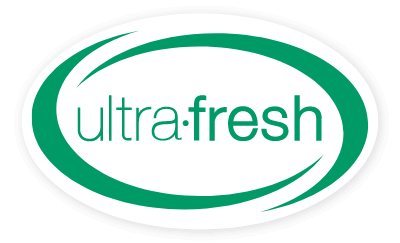You probably happened upon our blog because you were searching for info on "Cleaning a Sponge" or "How to Clean a Sponge". Well, you've come to the right place.
By now, it should come as no surprise to you that the sponge in your kitchen could be harboring several thousand, potentially millions of bacteria and mold spores.
In fact, a 2017 study found 362 bacterial species living in used kitchen sponges; 82 BILLION bacteria were thriving in just one cubic inch.
Gross, right?
No one likes the idea of cleaning their dishes with a germy-filled sponge.
Why You Need to Clean Your Sponge
While it might be a bit frustrating to realize that you must also clean the cleaning items in your household when you stop to think logically about why it makes sense.
The kitchen sponge is what you use to scrape off or pick up the stuck-on, sticky, gross leftovers from your meals.
All of those food scraps, sauces, and other grime that you clean off of the dishes end up accumulating within the sponge you used to clean up the mess in the first place.
Kitchen sponges are an ideal environment for bacteria and mold to live in.
Moisture, humidity, and some sort of organic material are all most microbes need to thrive. Your kitchen sponge is a place with all three.
Friends, this is why your kitchen sponge smells bad.
Check out this comprehensive blog for more reasons why your sponge needs to be kept clean.
How to Clean a Sponge
Bleach is the most effective way to clean a sponge.
In an analytical study conducted by The Good Housekeeping Institute, bleach was found to remove 99.9% of bacteria living within a regular kitchen sponge.
How to Disinfect a Sponge with Bleach
To clean your dirty sponge with bleach, mix ¾ cup of bleach into 2 liters of water. Let the sponge soak for at least 5 minutes. Thoroughly rinse with water. That’s it.
Cleaning your sponge with bleach is the most effective for removing bacteria and is quite simple. However, there is a caution to be had when using bleach, especially when using it as a tool to clean items on which you place your food on.
Also, you might not have bleach in your household.
So, here are a couple of other quick and easy ways to clean your kitchen sponges at home.
Cleaning a Sponge with Vinegar
Soak your sponge overnight in a mixture of 1 cup hot water, ½ cup white vinegar, and 3 tablespoons salt. The next morning, squeeze the sponge out several times to get rid of the accumulated cleaning liquid. Rinse thoroughly before use.
Cleaning a Sponge in Microwave
Put a wet sponge (with an emphasis on wet, DO NOT put a dry sponge in the microwave, it could set on fire) in your microwave and heat it on the high setting for 1-2 minutes.
Make sure you stay watching the sponge and do not walk away while it is in the microwave. Microwave settings differ greatly from model to model. You do not want to risk the sponge setting on fire if left inside the microwave for too long.
Cleaning a Sponge in Dishwasher
The dishwasher is also an easy and effective way to disinfect a sponge. It kills 99.9% of kitchen sponge bacteria.
Simply add your sponge to your household dishwasher while running a regular load. Ensure that you are using the 'heated dry' setting to maximize the effect.
How Ultra-Fresh Can Help Keep a Sponge Clean
It is important to clean a sponge often to get rid of the bacteria that exist. However, there is one problem - they grow right back!
By incorporating an antimicrobial agent into the sponge during the manufacturing process, the growth of odor-causing bacteria and mold is prevented before they can take hold and wreak odor-havoc.
The result is a kitchen sponge that doesn't smell.
Wondering what an antimicrobial agent is? Read more to find out.
How Does an Anti-Mold Treated Sponge Work?
Have you ever had a kitchen sponge that smells like mildew? Ick. Ultra-Fresh can help combat those musty kitchen sponge smells.
Here is an example of cellulose sponges after testing via the AATCC method 30, part III antifungal test method using Aspergillus niger.
[caption id="attachment_3597" align="alignleft" width="350"]

Mold growing on untreated sponge
[caption id="attachment_8898" align="alignright" width="350"]

Sponge treated with Ultra-Fresh antimicrobial technology remains free of fungal growth
As you can see from the photos, the untreated sponge is covered in mildew growth after the 7 day incubation period. Alternatively, the antimicrobial treated sponge prevents unwanted mold growth, along with their funky odors.
How Does an Antibacterial Treated Sponge Work?
Now, how does Ultra-Fresh fair against odor-causing bacteria that are so stinky, they trigger your gag reflex?
[caption id="attachment_3597" align="alignleft" width="350"]

Bacteria recovered from untreated sponge
[caption id="attachment_3600" align="alignright" width="350"]

Bacteria recovered from antimicrobial treated sponge
The image below illustrates these results in the form of a graph and one extra sample has been tested - the same treated sponge after squeezing in dishwater 500 times.
[caption id="attachment_3597" align="aligncenter" width="1024"]

Does an antimicrobial kitchen sponge work?
The bacteria on the untreated kitchen sponge grew exponentially (from about 50,000 to over 400,000!).
Clean or Replace?
There comes a point in every sponge’s life when no amount of cleaning can return it to a cleanliness level appropriate for reuse.Learn more about us or contact us for more information.
